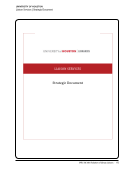46 · Survey Results: Survey Questions and Responses
LIAISON’S DEPARTMENT ASSIGNMENT
14. How are a liaison’s department assignment(s) determined? Check all that apply. N=67
Based on liaison’s subject expertise 65 97%
Based on liaison’s position 45 67%
Liaison self-selects the department(s) 20 30%
Distributed to equalize the ratio of faculty/researchers to liaisons 18 27%
Liaison follows an application process 6 9%
Other criteria 20 30%
Please specify the other criteria. N=20
Ability to build relationships with students and faculty in their assigned subject areas.
Affinity to other assignments
All appointments as liaisons, however they are initially suggested, are approved by the head of Scholarly Resource
Development department, the director of the relevant subject department, and the liaison’s direct supervisor.
Background and workload considered in new liaison assignments.
Based on institutional need to cover what needs to be covered.
Based on the needs of the library and departments.
Either where gaps are identified or new programs are initiated.
Informal conversation leads to a decision by the department head.
It is also historical assignment &random as people leave the organization.
Liaison is interested in learning a new area. Liaisons have sometimes chosen areas for these relationships.
Liaisons are hired to fill specific departmental roles, but these shift with staff changes and all of the other factors listed
may come into play in making those assignments. The non-liaison responsibilities of liaison librarians are also weighed
in balancing responsibilities. Equalizing is not strictly a matter of faculty/researcher ratios as different departments have
different needs in terms of instruction, collection development, etc.
May be based on need or availability, or the fit with other job duties.
Occasionally need-based, due to attrition.
Organizational history, established relationships.
Primarily, we recruit for a specific liaison position. Some liaisons have been willing to commit time and training to
learning a new subject area, e.g., the Clinical Services Liaison has spent up to 25% time learning new clinical domains in
order to expand services to new hospital departments.
Some assignments reflect the need for coverage, as best we can. Coordinators often cover when other librarians are
not available.
Subject specialist may negotiate with their colleagues and director if a balance in workload or change in subject
focus arises.
LIAISON’S DEPARTMENT ASSIGNMENT
14. How are a liaison’s department assignment(s) determined? Check all that apply. N=67
Based on liaison’s subject expertise 65 97%
Based on liaison’s position 45 67%
Liaison self-selects the department(s) 20 30%
Distributed to equalize the ratio of faculty/researchers to liaisons 18 27%
Liaison follows an application process 6 9%
Other criteria 20 30%
Please specify the other criteria. N=20
Ability to build relationships with students and faculty in their assigned subject areas.
Affinity to other assignments
All appointments as liaisons, however they are initially suggested, are approved by the head of Scholarly Resource
Development department, the director of the relevant subject department, and the liaison’s direct supervisor.
Background and workload considered in new liaison assignments.
Based on institutional need to cover what needs to be covered.
Based on the needs of the library and departments.
Either where gaps are identified or new programs are initiated.
Informal conversation leads to a decision by the department head.
It is also historical assignment &random as people leave the organization.
Liaison is interested in learning a new area. Liaisons have sometimes chosen areas for these relationships.
Liaisons are hired to fill specific departmental roles, but these shift with staff changes and all of the other factors listed
may come into play in making those assignments. The non-liaison responsibilities of liaison librarians are also weighed
in balancing responsibilities. Equalizing is not strictly a matter of faculty/researcher ratios as different departments have
different needs in terms of instruction, collection development, etc.
May be based on need or availability, or the fit with other job duties.
Occasionally need-based, due to attrition.
Organizational history, established relationships.
Primarily, we recruit for a specific liaison position. Some liaisons have been willing to commit time and training to
learning a new subject area, e.g., the Clinical Services Liaison has spent up to 25% time learning new clinical domains in
order to expand services to new hospital departments.
Some assignments reflect the need for coverage, as best we can. Coordinators often cover when other librarians are
not available.
Subject specialist may negotiate with their colleagues and director if a balance in workload or change in subject
focus arises.












































































































































































































